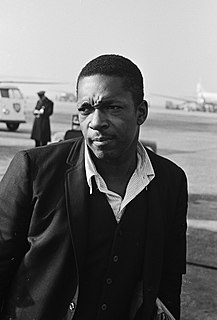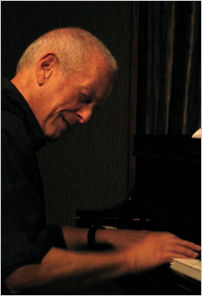
Coleman Randolph Hawkins, nicknamed "Hawk" and sometimes "Bean", was an American jazz tenor saxophonist. One of the first prominent jazz musicians on his instrument, as Joachim E. Berendt explained: "there were some tenor players before him, but the instrument was not an acknowledged jazz horn". Hawkins biographer John Chilton described the prevalent styles of tenor saxophone solos prior to Hawkins as "mooing" and "rubbery belches." Hawkins cited as influences Happy Caldwell, Stump Evans, and Prince Robinson, although he was the first to tailor his method of improvisation to the saxophone rather than imitate the techniques of the clarinet. Hawkins' virtuosic, arpeggiated approach to improvisation, with his characteristic rich, emotional, loud, and vibrato-laden tonal style, was the main influence on a generation of tenor players that included Chu Berry, Charlie Barnet, Tex Beneke, Ben Webster, Vido Musso, Herschel Evans, Buddy Tate, and Don Byas, and through them the later tenormen, Arnett Cobb, Illinois Jacquet, Flip Phillips, Ike Quebec, Al Sears, Paul Gonsalves, and Lucky Thompson. While Hawkins became well known with swing music during the big band era, he had a role in the development of bebop in the 1940s.

At Carnegie Hall is a live album by The Thelonious Monk Quartet with John Coltrane.
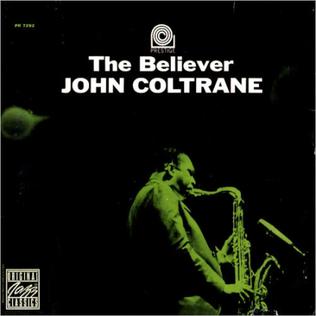
The Believer is a jazz album credited to John Coltrane released in 1964 on Prestige Records, catalogue 7292. As Coltrane's fame grew during the 1960s, long after he had stopped recording for the label, Prestige assembled varied recordings and reissued them as new albums in Coltrane's name. The original album consists of three previously unissued tracks by Coltrane as a leader from two separate recording sessions in 1958. Subsequent CD versions of the album have added two tracks recorded in 1957 from New Jazz Records 8228 The Ray Draper Quintet featuring John Coltrane released in 1960. All tracks were recorded at the studio of Rudy Van Gelder in Hackensack, New Jersey.

Coltrane Jazz is the sixth studio album by jazz musician John Coltrane, released in 1961 on Atlantic Records, catalogue SD 1354. The song "Village Blues" is noted as a landmark recording, as it marks the first session date of the early John Coltrane Quartet on record. Featured alongside Coltrane are pianist McCoy Tyner, drummer Elvin Jones, and bassist Steve Davis

Trane's Blues is a compact disc credited to the jazz musician John Coltrane, released in 1999 on Blue Note Records, catalogue 98240. It comprises recordings from sessions for Blue Note and United Artists Records as a sideman for Paul Chambers, Sonny Clark, Johnny Griffin, and Cecil Taylor that were issued respectively on their Whims of Chambers, Sonny's Crib, A Blowin' Session, and Hard Driving Jazz albums. Two selections are from Coltrane's own 1957 Blue Train, and "One for Four" had been previously unissued. "Trane's Blues" had been issued on the compilation High Step in 1975, previously known as "John Paul Jones" and named after himself, the bass player Chambers, and the drummer Philly Joe Jones. Like Prestige Records before them, as Coltrane's fame grew long after he had stopped recording for the label, Blue Note used varied recordings, often those where Coltrane had been merely a sideman, and reissued them as a new album with Coltrane's name prominently displayed. In this case, the Big Four conglomerate EMI continued that earlier practice.

Live at Birdland is a 1964 album by jazz musician John Coltrane. Despite its title, only the first three tracks were recorded live at the Birdland club; the rest are studio tracks. Among them is "Alabama", a tribute to four children killed in the 16th Street Baptist Church bombing, an attack at a Birmingham, Alabama church by white supremacists. The album's original pressing accidentally included a false start - this was corrected in later copies, but restored in CD editions. The album also features a live recording of "I Want to Talk About You", a song Coltrane had recorded on his 1958 album Soultrane, this time with an extended cadenza.

Tenor Madness is a 1956 jazz album by Sonny Rollins. It is most notable for its title track, the only known recording featuring both Rollins and John Coltrane.

Delightfulee is an album by jazz trumpeter Lee Morgan released on the Blue Note label in 1966. It was recorded on April 8 & May 27, 1966 and features performances by Morgan with a quintet featuring Joe Henderson, McCoy Tyner, Bob Cranshaw and Billy Higgins and a big band featuring Ernie Royal, Tom McIntosh, Jim Buffington, Don Butterfield, Phil Woods, Wayne Shorter, Danny Bank and Philly Joe Jones with arrangements by Oliver Nelson.
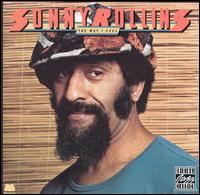
The Way I Feel is an album by jazz saxophonist Sonny Rollins, released on the Milestone label in 1976, featuring performances by Rollins with Patrice Rushen, Lee Ritenour, Billy Cobham, and Bill Summers with a brass section added on five tracks.

Sonny Rollins and the Big Brass is an album by jazz saxophonist Sonny Rollins, recorded for the MetroJazz label, later reissued on Verve Records as Sonny Rollins/Brass - Sonny Rollins/Trio.

Our Man in Jazz is an album by jazz saxophonist Sonny Rollins, released by RCA Victor featuring July 1962 performances by Rollins with Don Cherry, Bob Cranshaw, and Billy Higgins. These performances have been described as contrasting from Rollins' previous style by moving to "very long free-form fancies, swaggering and impetuous".
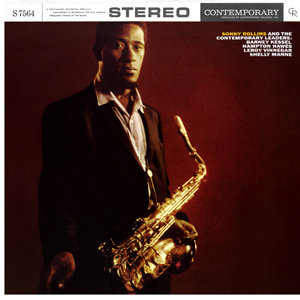
Sonny Rollins and the Contemporary Leaders is a 1958 album by jazz saxophonist Sonny Rollins, recorded for the Contemporary label, featuring performances by Rollins with Hampton Hawes, Barney Kessel, Leroy Vinnegar, and Shelly Manne with Victor Feldman added on one track. It was the last record Rollins produced before a hiatus from recording and performing in public, before his return with The Bridge in 1962.
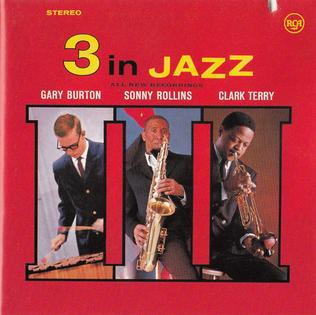
3 in Jazz is an album released on the RCA label which features tracks from three separate sessions by vibraphonist Gary Burton's Quartet, Sonny Rollins & Co. and the Clark Terry Quintet recorded in 1963.

The Ray Draper Quintet featuring John Coltrane is the second album by tuba player Ray Draper recorded in 1957 and released on the New Jazz label.
Frank Haynes, Jr. was an American jazz tenor saxophonist who recorded in the 1950s and 1960s.

Bluesville Time is an album by pianist Cedar Walton which was recorded in 1985 and released on the Dutch Criss Cross Jazz label.

Sonny Rollins at Music Inn/Teddy Edwards at Falcon's Lair is a live split album featuring saxophonists Sonny Rollins and Teddy Edwards, recorded for the MetroJazz label in 1958.


